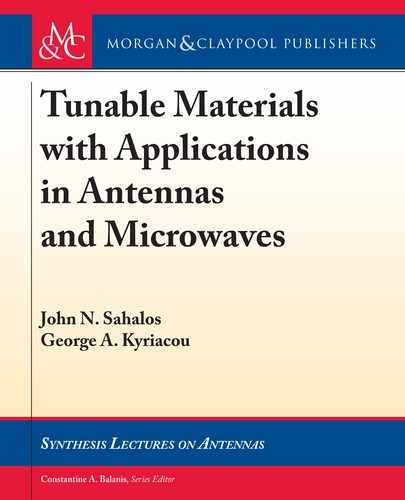
126 3. FINITE FERRITE SAMPLES
fast (almost exponentially) toward the interior of the slab away from either surface x D Cd=2
or d=2. Consequently, volume waves cannot propagate purely transversely to the direction of
DC magnetization (z-axis). Only surface modes can do that.
It is again interesting to examine the MSBVW characteristics with respect to slab thick-
ness. e above proves that volume waves are not supported for pure transverse propagation. For
the infinite thickness limit kd >> 1, Eq. (3.144), obtained for k
y
D 0 and describing the lowest
order mode .n D 0/, gives ! ! !
i
or !
H
. Again, this approaches the plane-wave limit
and the wave is purely propagating in the z-direction (along DC magnetization). In contrast,
in the electrically thin slab (or film), where kd << 1, propagation is almost transverse k
z
! 0,
and this occurs at the maximum frequency ! Œ
2
H
C
H
1=2
or ! ! Œ!
2
i
C !
i
!
m
1=2
.
3.23 MAGNETOSTATIC SURFACE WAVES .1 C X / > 0
e above analysis as well as the original work of [13] shows that outside range II, where .1 C
X / < 0, the only possible modes are those of the surface-wave type. is is supported by the
requirement that k
2
xi
< 0 or that k
xi
be imaginary to obey the dispersion relations. In view of
this, one may set k
xi
equal to
k
xi
D j˛
i
or k
2
xi
D ˛
2
i
: (3.146)
e analysis for volume modes is still applicable as long as the argument of the functions is
allowed to be complex. A more appropriate characteristic equation for surface waves in ranges I
and II is obtained by substituting (3.146) into the previous expressions. First, the x-dependence
of Eq. (3.114) may be rewritten as:
f
i
.x/ D A
0
x
e
C˛
i
x
C B
0
x
e
˛
i
x
: (3.147)
Writing .sinh/ into an exponential form we have
A
0
x
D
B
x
C jA
x
2
D
1
2 sinh
.
˛
i
d
/
0e
e
˛
i
d=2
0
0e
e
˛
i
d=2
(3.148a)
B
0
x
D
B
x
jA
x
2
D
1
2 sinh
.
˛
i
d
/
0
0e
e
˛
i
d=2
0e
e
˛
i
d=2
: (3.148b)
Substituting the above coefficients back into (3.147) yields
f
i
.x/ D
1
sinh
.
˛
i
d
/
0e
sinh
Œ
˛
i
.x C d=2/
0
0e
sinh
Œ
˛
i
.x d=2/
: (3.149)
Alternatively, the same expression can be obtained by substituting (3.146) directly
into (3.126). Moreover, the characteristic equation (3.129) reads as follows:
2.1 CX / ˛ ˛
i
coth
.
˛
i
d
/
C .1 C X /
2
˛
2
i
C ˛
2
k
2
i
k
2
y
D 0: (3.150)
..................Content has been hidden....................
You can't read the all page of ebook, please click here login for view all page.
